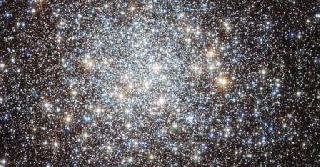
Messier 9. Photo: NASA & ESA
PASADENA (BNS): The NASA/ESA Hubble Space Telescope has produced a detailed image of Messier 9, a globular cluster, that lies around 25 000 light-years from Earth, near the centre of the Milky Way.
This ball of stars is too faint to be seen with the naked eye however Hubble has captured the highest resolution image yet made of Messier 9, ESA said.
Over 250 000 of them are neatly focused on the detector of Hubble's Advanced Camera for Surveys, in an image which covers an area no bigger than the size of the head of a pin held at arm's length.
As well as showing the individual stars, Hubble's image clearly shows the different colours of the stars, it said.
A star's colour is directly related to its temperature, counter-intuitively, perhaps, the redder it is, the cooler it is; and the bluer it is, the hotter. The wide range of stellar temperatures is clearly displayed by the broad palette of colours visible in Hubble's image of Messier 9.
Messier 9, as its name suggests, was discovered by the great French astronomer Charles Messier in 1764. Even through the most advanced telescopes of the day, none of the stars in the cluster could be seen individually.
Messier, seeing only a faint smudge, therefore classified the object as a nebula or 'cloud' in Latin. It was only later in the 18th century that astronomers, most notably William Herschel, began to spot stars within the cluster.
 Previous Article
Previous Article Next Article
Next Article













The Indian Air Force, in its flight trials evaluation report submitted before the Defence Ministry l..
view articleAn insight into the Medium Multi-Role Combat Aircraft competition...
view articleSky enthusiasts can now spot the International Space Station (ISS) commanded by Indian-American astr..
view article